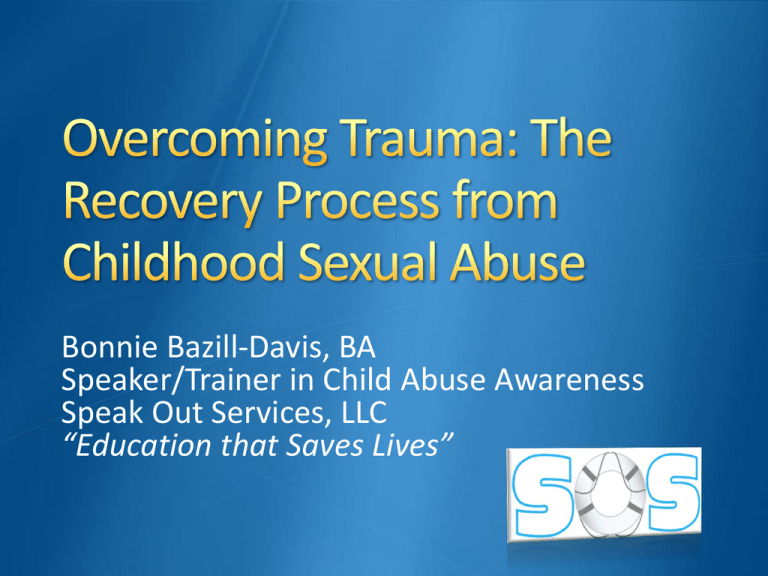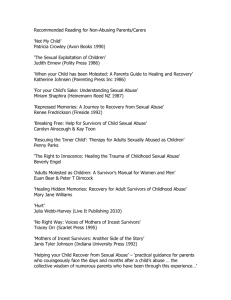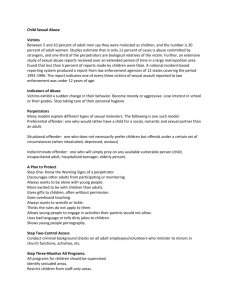
Bonnie Bazill-Davis, BA
Speaker/Trainer in Child Abuse Awareness
Speak Out Services, LLC
“Education that Saves Lives”
• Problems are firmly rooted in today and
not the past
• Time of “maintenance” are recognized
and embraced for healing
• Healthy boundaries have been
established with offenders/deniers
• A sense of self-worth is restored
• Healthy “tools” are employed to handle
life’s emotional states
• Peace has been achieved over the
experience – it loses its power to
dominate/control your life
• Definition of Sexual Abuse and
Indicators
• Test Your Knowledge Bingo
• A Shoe Story of Incest
• Five “A’s” of Recovery
Awakening, Absorbing,
Alleviating, Accepting, Advocating
• How to Help Kids
• Your Five “A’s” – Applications for
Practice
Sexual activity which may be touching or
non-touching performed on a child for the
gratification of the perpetrator. Ohio age
of consent is 16.
Incest is sexual abuse perpetrated within a
family system, including friends of the
family. SIA defines incest as sexual abuse
including a betrayal of trust.
All childhood trauma or excessive stress
has some common indicators including:
• Falling behind developmentally and/or
academically
• Inability to focus attention
• Personality or mood changes
• Regressive behaviors (thumb-sucking,
wetting, etc.)
• A knowledge of sex acts or language
beyond developmental level
• Acting out in a sexual way with other
children or toys and is unable to stop
behavior when re-directed
• Excessive masturbation, may again be
unable to follow re-direction
• Excessive washing
• Unusual fears or anxieties – bathrooms,
changing clothing, certain people, etc.
• Eating disorders
• Difficulty walking, stained/bloody
underclothing, STD’s, early pregnancy
• Randomly write the numbers 1 – 9 in
the boxes on your card
• The numbers on your card correspond
to the number of questions
• Give yourself an “X” for every correct
answer
• Yell “BINGO” for a prize!
True or False:
All children will experience
sexual abuse as traumatic.
True or False:
Dissociation, the perceived
detachment of the mind from the
emotional state or the body,
occurs naturally in most people.
True or False:
Forgiveness is the ultimate
goal of the recovery
process.
True or False:
All survivors should confront
their offenders at some point
in the recovery process.
True or False:
Psychological trauma can
lead to physical changes in
the brain.
True or False:
All children who experience
sexual abuse will need
therapy.
True or False:
It is possible to recall an earlier
abuse experience without an
actual “picture” memory.
True or False:
Parenting methods that focus
on positive interactions will
help reduce the symptoms of
trauma in children.
True or False:
Art and play therapies have
some distinct advantages
for abused children.
Climbing the ladder to the light is a PROCESS and not an event!
• May be full or partial
awareness with or without
actual visual mental pictures
of abuse
• May be sensory imprints
• Awareness may be sudden or
gradual
• Awareness and recognition
of effects may be ongoing
throughout life
Implicit Memory “Feelings/Sensations”
• Non-conscious and non-verbal
• Emotional, senses
• Procedural (driving a car)
Explicit Memory “Movie-in-Your-Head”
• Conscious
• Verbal
• Contextual
Memories in a Box
A study of 46 subjects with PTSD indicated that
traumatic memories were retrieved, at least
initially, in the form of dissociated mental
imprints of the traumatic experience including:
•Visual
•Olfactory (smells)
•Affective (feelings/knowledge)
•Auditory
•Kinesthetic (body)
Van der Kolk, B. A., & Fisler, R. (1995). Dissociation and the fragmentary
nature of traumatic memories: Overview and exploratory study. Journal of
Traumatic Stress, 8, 505-525.
In a study of 129 women who had documented
forensic evidence of child sexual abuse the
following was found during interviews 17 years
later:
•38% had no recall of the sexual abuse
•Under the age of 7
•Abused by someone they knew
Journal of Consulting and Clinical Psychology 1994, Vol. 62, No. 6,
1167 - 1178
The hippocampus is involved
in learning and memory
processes.
Adult trauma survivors have
shown significant decreases in
the size of the hippocampus,
helping to understand
memory complications.
Bremner, J. D. (1999). The Lasting Effects of
Psychological Trauma on Memory and the
Hippocampus Yale University School of
Medicine. Leadershipcounil.org
• Chemical dependency is common for trauma
survivors
• Chemicals help to numb emotional pain
• Sobriety important to recovery processes
• For some, treatment for chemical
dependency may need to include therapy for
sexual abuse to prevent relapse
National Institute on Drug Abuse, NIDA Notes, Vol. 17, Number 1 April 2002
Make this go away - I want my apple back!!!
• Group involvement to understand that others
have similar experiences
• Fear for sanity and mental health
• May have no “evidence” or family who
supports memories
• With incest, changes to family relationships
and feelings toward family members
• No good options – “I’m nuts or my father is a
child molester”
Processing Emotions
Art Therapy – Emotions Run Amok
• Outlets for anger and rage, which may need
physical release
• Grief, loneliness, and loss of family (important
to develop family of choice)
• Anxiety/panic and depression
• Blame and shame - “we were fine until you
messed it up”
• For incest, strong mechanisms of denial
within the entire family system
• Self-blame
• Self-hatred, loathing
• Begins pattern of “victim thinking” in
multiple life settings (relationships,
work, finances, etc.)
• Uncertain of “normal”
Abuser
Non-Offending
Parent
Target
Trauma-Focused Cognitive Behavioral Therapy (adults &
kids) involves:
• Education to normalize the effects of abuse
• Affect regulation and relaxation to cope with feelings
and self-soothe
• Overcoming learned fears of trauma reminders
• Helping the survivor construct a non-distorted
trauma narrative to tell a coherent account while
connecting their thoughts, feelings, and behaviors.
Play Therapy can be form of TF-CBT for children and
uses sand trays, art, toys, and games in sessions to help
children recover from the trauma. Benefits are:
• Kinesthetic involvement – touch and feel
• Dichotomous thinking – helps examine all or nothing
thinking
• Symbolic communication – helps with children’s fear
of telling
Goodyear-Brown, Paris, LCSW, RPT-S, “How Children Tell: Non-Linguistic Narratives
in Trauma Work with Children” APSAC Colloquium, July 2011.
Hypnotherapy
The subconscious is accessed through deep
relaxation in the therapy session.
EMDR
Eye Movement Desensitization and Reprocessing
therapy helps the client access the traumatic
memory network via eye movement exercises
facilitated by the therapist.
• Affirmed my strengths, did not emphasize
labels, and above all else, listened
• Were not afraid of my rage and gave me an
outlet for expression
• Offered art therapy and Gestalt techniques,
such as “empty chair” exercises
• Encouraged my involvement in groups, both
therapy and outside support groups
The Tangled Web
Physical Boundaries
Lack of control over your own body
Lack of escape from abusive environment
Emotional / Mental / Family Role
Caretaking of perpetrator (with incest)
Spouse/daughter role reversal
Sexual / Touch Boundaries
Confusion between normal touch and sexual touch
Lack of healthy sexual boundaries as teenager/adult
Sex/love confusion
Spirituality is a complicated issue for many
survivors with many faucets including:
• Cultural depiction of God as male and some
experiencing abuse by a man
• Fearing God as angry and hurting those who do
not obey
• Sexual abuse may have had religious connection
for some such as clergy abuse, cult abuse or
extreme religious righteousness by the offender or
denier/caregiver.
How Do You Define It?
How do you forgive someone who has never asked for
forgiveness or owned the behavior?
• Only achieved after doing the emotional work and seeing the
power balance “shift” in our relationship.
• Development of empathy towards my father.
• Creating new definition for forgiveness – not “forgive and
forget”
• Agreeing to disagree – accepting that I would never get an
apology for the abuse, but accepting “lesser” apologies as
enough.
Finding Meaning
from Pain
• Report suspicions
• Believe children when they disclose yet
be cautious of asking leading questions
• LISTEN and PLAY
• Educate to dispel mental distortions
and set healthy boundaries
• Be cautious of touch with sexually
abused child
• See the child as strong – strength-based
approach
• Provide sincere positive support and
statements in 80% of interactions
• Provide safe place so child can calm self
• Provide creative outlets for feelings
• Offer choices for regaining power
Your five applications
or insights gained from
this workshop!
Questons?
For a list of additional SOS
trainings visit:
www.speakoutservices.com
937.371.9923
Bonnie@speakoutservices.com








